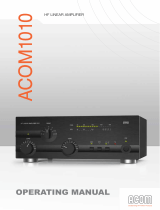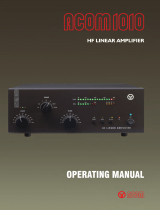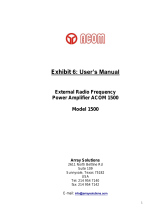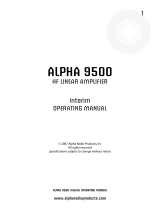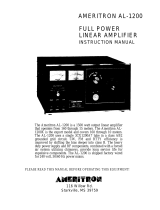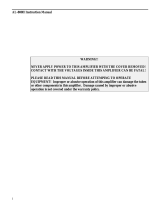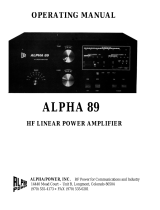Page is loading ...

1
ACOM1500 TUBE REPLACEMENT
This step-by-step instruction is about the tube replacement and idling currents
re-adjustment of ACOM1500 power amplifier. Please follow all details closely since
the work is difficult, with many details to keep track about, and might be
dangerous too. Do not hesitate to contact your local dealer or nearest ACOM's
service for any advice. Please don't attempt tube replacement by yourself, if you
don't feel comfortable with repairs!
SAFETY FIRST!
W A R N I N G HIGH VOLTAGE!
===========================
The amplifier works with high voltages up to 3000V which is LETHAL! For your
safety pull the amplifier power plug out of the mains wall outlet and WAIT AT
LEAST 30minutes EACH TIME BEFORE you remove the cover of the amplifier. Disconnect
all cables from the amplifier (grounding last). Do not touch any part inside while
the amplifier is open because some residual voltages may still be present!
1. Removing the top cover.
Using a Philips-2 screwdriver, unscrew 9 pcs of "eco-fix" flange-button head
screws to release the top cover (2x3 pcs on each bottom-side edge, and three more
on the rear-top edge of the box).
Lift the rear edge of the cover slightly (to 2-3cm) and then pull the cover
backwards, in order to release it from front-panel's chutes. Remove the top cover.
2. Discharging HV capacitors.
You will see inside:
- the MAINS PCB that is mounted on an aluminum sub-chassis, just above the big HV
transformer;
- the HV rectifier PCB in front of the MAINS PCB (with four big diodes, one wire-
wound resistor, and one disc ceramic capacitor on it);
- the HV filter PCB, located just below the HV rectifier (with 8 electrolytic
capacitors on it).

2
c) Before proceeding, please make sure that no residual DANGEROUS VOLTAGES are
present in the amplifier. For this purpose take approximately 1m of WELL-INSULATED
lead (adequate for 3000V). Bare it to about 1cm at both ends.
Tighten one end of the wire under the GROUND STUD (on the rear panel). Only
AFTERWARDS, holding the wire BY THE INSULATION, at a distance of minimum 10cm (4
Inch), ground with the tip of its second end momentarily and consecutively each
part on the HV rectifier PCB, especially:
- the HV output J3;
- the wire-wound resistor R12 on its both sides;
- the four HV diodes on their both sides.
With the tip of the same permanently grounded wire, on the MAINS PCB ground
momentarily the diode D19 on its both sides (D19 is located at the PCB edge, near
the powerful MOSFET transistor which is installed on the chassis).
3. Removing the Screen above the RF Deck.
Using a Philips-1 screwdriver, unscrew 18 pcs of countersunk-head screws to
release the aluminum cover above the RF deck. Lift and pull the cover to remove
it.
Repeat step 2(c) to discharge any residual high voltages, this time grounding
momentarily the copper strip of the plate anti-parasitic suppressor and the tube
anode cap with the tip of the permanently grounded wire.

3
Check whether the HV LID crowbar makes a reliable short-circuit across the HV
wiring when the cover is missing.
4. Old Tube Removal.
W A R N I N G HIGH VOLTAGE!
===========================
Prior to continue you must be absolutely sure that there are no residual voltages
in the amplifier - see (2) and (3) above!
Be careful - the tube may be VERY HOT!
First unthread the temperature sensor (which looks like a small transistor), out
of the rubber chimney. Push gently the chimney towards the tube center while
taking care not to bend the three leads of the sensor and fully unthread it.
Now unscrew both M3 screws that hold the anode clip to the UHF suppressor (look at
the two red arrows in the picture below). Save the two screws and washers.

4
Unclip the anode spring clip from the tube cap - look at the yellow arrow (2)
above - and then unthread the rubber chimney out of the anode heat sink (together
with the anode spring clip inside). Keep an eye on the temperature sensor.
While holding the tube for the heat sink, turn it to 120° (a third of a full turn)
and counter clockwise, in order to release the tube from the socket spring
contacts. Be sure to avoid overstraining the contacts while pulling the tube
vertically up until you get it out of the socket.
5. Installing a New Tube
Observe the key cog inside the tube leading hole and three 120°- spaced grooves on
the socket central guide pin:
Orient the tube so that the cog matches any one of the three grooves. Slide the
tube down gently while preserving the socket's spring contacts from any
overstrain.
If needed, turn the tube slightly in both directions in order to feel the 120°
contacts gap and fit it between the socket spring contacts. Then align the tube
vertically by sliding it slightly up or down, in small steps, until its radial
contacts find their way between socket spring contacts, and only then turn the
tube harder and 120° (a third of a full turn) clockwise until you feel a firm
stop.

5
Orient the silicon rubber chimney (together with the anode clip inside) so that:
- the temperature sensor could be threaded through the small hole later;
- the anode clip stripe could be screwed to its original place.
Now thread, by small steps in parallel, the chimney over the tube plate heat sink.
Keep track not to bend the temperature sensor during this operation! Thread the
temperature sensor into its hole into the rubber chimney. Clip the spring contact
to the tube plate and precisely orient the nut holes to the UHF-suppressor stripe
holes. Align carefully the rubber chimney, so that its bottom edge firmly touches
the tube deck at the base - otherwise a part of airflow would be exhausted
uselessly and the tube might over-heat!
At last, install the UHF suppressor stripe using two original screws and lock
washers (should have been preserved at previous steps). Tighten the screws
properly.
e) Ensure that after the tube replacement all the amplifier wiring is restored to
its original condition.

6
6. Adjustment of the Idling Current.
After each tube replacement, the BIAS voltage needs to be re-adjusted in order to
individually align the tube operating regime. There is an information screen
"Plate Current" on the display, foreseen to monitor the plate current during this
procedure. The two adjustment trimmer-potentiometers are located on the MAINS PCB.
a) Install the aluminum RF-screen cover of the RF deck (18 countersunk screws).
Put and tighten provisionally two small strip pieces to two of the nuts on the
middle chassis wall which are close to the HV LID crowbar as well as to the cover-
presence micro-switch sensor (around the two yellow arrows in the picture below).
These will provisionally imitate a top cover presence during the adjustment
procedure. Check that the provisional pieces are tightened reliably in order not
to let them slip the crowbar or the cover-sensing switch during the next
operations.
W A R N I N G HIGH VOLTAGE!
===========================
Be careful - HIGH VOLTAGES up to 3000V will exist permanently on the accessible
wiring and on the PCBs which is LETHAL! Keep away of the parts and the PCBs! Keep
track that nobody could access the amplifier and do not leave it without
supervision during all the time that the amplifier is with the cover removed!
Connect a dummy load (or an antenna) to the output. Install all cables to the
exciter as usually. Now, feed mains voltage, turn on the amplifier and let the
tube warming up for at least 15 minutes in STANDBY mode. Safeguard the amplifier
and all accessible HV parts during this period!

7
Select same bands (preferably lower) on both the amplifier and the exciter.
Use a small-size flat-tip insulated screwdriver for the next adjustments. Locate
the two trimmer potentiometers RP1 and RP2 (marked "BIAS1" and "BIAS2") on the
MAINS PCB. They control the idling (zero-signal) plate current of the tube for
low- and high- RF drive levels respectively.
Please note that RP2 will affect both levels, while RP1 - only the low level of
the idling current. That is why, the high level is adjusted the first, and only
then is set the low level (according to the procedure described below).
b) Select the "Plate Current" information screen on the LCD. Go to the OPER mode.
Apply very small drive power in CW mode key down (1-3W RF). Following the plate
current, adjust R2 (BIAS2) to 250mA (CCW rotation will increase the current and
vice versa). Don't exceed 15 seconds with the PTT on. If you need more time for
fine adjustment, make a pause of 1-2 minutes to let the tube cooling down and then
repeat the adjustment.
c) For RP1 (BIAS1) adjustment press the PTT but do not apply any RF drive. For
instance, select SSB mode with the exciter MIC and POWER regulators set to
minimum; in CW you may press the TX button but without closing the CW key.
While monitoring the plate current, adjust RP1 (BIAS1) to set the plate current to
70mA (flickering between 60 and 80mA is OK). A CW rotation of RP1 will increase
the current and vice versa. The adjustment of RP1 (BIAS1) does not affect the
previous step so you are ready.
7. Reassembling the Amplifier
After the adjustment procedure is completed, switch off the amplifier and pull the
amplifier power plug out of the mains wall outlet. Wait for a minimum five minutes
to expire and only then remove both "cover-presence" imitators. Do not hurry to

8
remove them earlier since the residual voltages will be still too high! You can
expect a small electric sparkle when the HV crowbar is closing which is normal.
Do not touch any part inside when reassembling the amplifier since residual
voltages may exist and the tube could be still hot!
At last, install the top cover again as described below. Be careful to align
screws thread to the nuts and do not force them since any captive nut on the
chassis might be damaged.
a) Put the cover above the chassis, while holding its rear edge slightly lifted
(to 2-3cm or 1"). Align its horizontal and the two vertical front edges to the
respective front-panel chutes. Then push gently the cover forwards so that its
front edges enter the panel chutes. Take care especially to the bottom corners.
b) Screw in loosely all 9 pcs of "eco-fix" flange-button head screws. Use a
Philips-2 screwdriver.
c) Tighten all 9 screws properly while pressing continuously the cover forwards
and to the bottom.
- E N D -
/

